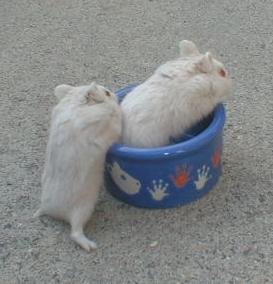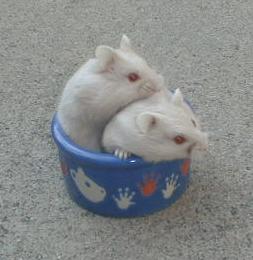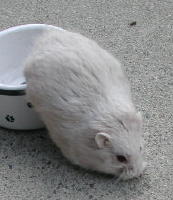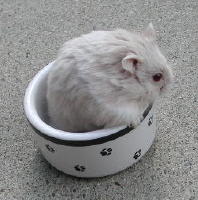



various lightings
To breed a Champagne, you would start with two different three-gene colors like Red-eyed Lilac (RE Lilac) and Blue Beige (Dark Beige or Black-eyed Lilac work equally as well if you make the substitutions). Between these two hamsters, you cover all four of the combinable Campbells color genes. Since RE Lilac is the combined color for Black, Opal, and Argente, you are only missing the Black-eyed Argente gene to get to Champagne. Since Blue Beige is the combined color for Opal, Argente, and Black-eyed Argente, you are only missing the Black gene to get to Champagne.
So you would breed the RE Lilac to the Blue Beige. Since Opal and Argente are the overlapping colors, you should get all Blue Fawn babies carrying Black and Black-eyed Argente. You would then breed two of these Blue Fawn babies together. From this pairing, you should get approximately 9/16 Blue Fawns, 3/16 RE Lilac, 3/16 Blue Beige, and 1/16 Champagne.
It is a bit trickeir but still doable if you start with a three-gene color and a two-gene color. Let's take the example of breeding an RE Lilac to a Beige. RE Lilac is the three gene color for Opal, Black, and Argente. Beige is the two-gene color for Argente and Black-eyed argente. All four of the combinable color genes are represented. So if you breed the RE Lilac to the Beige, you should get all Argentes carrying Opal, Black, and Black-eyed Argente. You then breed two of these Argentes together. From this pairing of argentes, you should get approximately 27/64 Argentes, 9/64 Beige, 9/64 Dove, 9/64 Blue Fawn, 3/64 RE Lilac, 3/64 Dark Beige, 3/64 Blue Beige, and 1/64 Champagne.
As you can see, it can take a lot of litters to get to Champagne this way with a lot of other colors popping up along the way. The reality is that with a single pair, you may never get a blue beige since these are all statistics. Again, it is preferable to start with two different three-gene colors instead. Starting with two different two-gene colors only makes the process more complicated and with a lesser chance to get to Champagne.